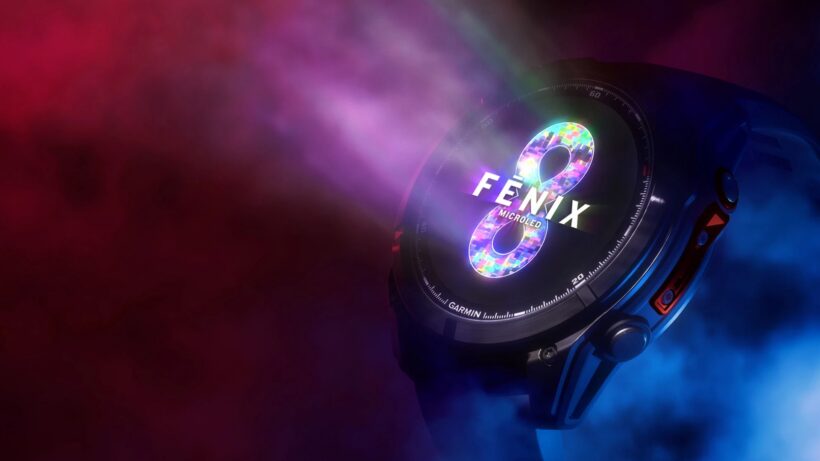Everything you need to know about Garmin's new $2,000 flagship sports watch
Garmin has unveiled the Fenix 8 Pro, its next-generation flagship sports watch, with two enormous, first-of-their-kind features.
The new series marks the debut of a groundbreaking MicroLED display, making it the first watch from any major company to use the technology.
It also signals Garmin’s official return to cellular connectivity—but on its own terms—with integrated inReach satellite and LTE technology for phone-free communication and SOS.
Garmin has split the mid-cycle update into two distinct tiers. The top-of-the-line Fenix 8 Pro MicroLED comes in a 51mm titanium case, features the stunning new display, and is priced at an ultra-premium $2,000/£1,729.99.
For those not ready to make the leap to the new screen technology, Garmin is also offering the Fenix 8 Pro AMOLED, which features the same core software and connectivity but with a more traditional display, available in both 47mm and 51mm sizes.
Both are available to order from Garmin from 8 September.

Two huge upgrades coming via the mid-cycle update
The new screen technology promises to solve the long-standing trade-off between display types, offering incredible brightness (in this case, up to 4,500 nits for superior readability in direct sunlight) while also providing rich colours and perfect blacks, similar to those of an AMOLED.
The new inReach and LTE combination, meanwhile, has the potential to turn the Fenix 8 Pro into a powerful standalone communication device for adventurers, enabling messaging, calls, and emergency SOS, both on and off the grid.
In addition to the new hardware, the Fenix 8 Pro also inherits Garmin’s full suite of latest software features. These include Running Tolerance, Step Speed Loss, and Evening Report, and debuted on the Forerunner 970 and were subsequently rolled out to the Fenix 8 and Venu X1 just last week.
On paper, this mid-cycle update has delivered by far the most feature-packed sports watch Garmin has ever released. So, let’s dive a little deeper into the details of the Fenix 8 Pro line.
Five key things to know about the Garmin Fenix 8 Pro

1. The MicroLED display is a genuine game-changer
We in the tech industry can be guilty of using the phrase ‘game-changer’ loosely. This, though, represents a giant technological leap for smartwatches.
Garmin’s interpretation of MicroLED in the Fenix 8 Pro uses over 400,000 individual, microscopic LEDs to create an image, delivering the perfect black levels and vibrant colours of an AMOLED screen but with a staggering peak brightness of 4,500 nits.
In simple terms, this display should be incredibly bright and clear in all conditions, from a dark room to the brightest direct sunlight on a mountain top.
We’ll wait until our full review testing to confirm, but it would be a shock if this didn’t become the early benchmark for flagship smartwatch displays to follow.
2. Garmin is back in the cellular game, but on its own terms
This isn’t standard LTE like on an Apple Watch or Samsung Galaxy Watch. Like we saw with the brand’s last cellular-enabled device, the Forerunner 945 LTE released in 2021, it’s doing things its own way.
The Fenix 8 Pro’s connectivity is powered by Garmin’s own inReach technology, which combines LTE and satellite networks. This requires a Garmin subscription, not a plan from your mobile carrier. At the time of writing, Garmin has a list of countries that offer LTE coverage for the Fenix 8 Pro, which is extensive.
The focus here, as you would expect, is mostly on adventure and safety. The Fenix 8 Pro unlocks phone-free voice calls and messaging with other Garmin Messenger app users, LiveTrack location sharing, weather updates, but, most crucially, the ability to trigger an interactive SOS to a 24/7 response centre via satellite when completely off-grid.

3. There are limited versions (especially for the MicroLED model)
Given that the MicroLED edition features burgeoning technology and forms part of a mid-cycle update, it’s no surprise to see the range generally offered in limited SKUs.
The 51mm MicroLED model, specifically, features a titanium case and bezel, a scratch-resistant sapphire crystal lens, and a dive-rated case with leakproof inductive buttons. Aside from that display change, it looks identical to the Fenix 8 51mm. Yet, unlike that watch, this is only available in one version (which features a gray case, black band with orange sensor guard).
There are more SKUs of the standard, AMOLED edition of the Fenix 8 Pro—mostly by virtue of it being available in 47mm and 51mm. Buyers can choose between a gray or titanium case for this one, with the out-of-the-box bands also featuring the brand’s brown leather, black silicone, and graphite silicone.
4. It inherits all of Garmin’s latest software smarts
The Fenix 8 Pro isn’t just about new hardware—though those are the headline changes here.
It also comes with the complete suite of advanced training and wellness features that were, as we mentioned above, recently introduced to other top-tier Garmin watches.
This includes the excellent Running Tolerance feature for managing weekly mileage, Endurance Score, and Hill Score for measuring your fitness, and new wellness tools like the Evening Report and Smart Wake Alarm. This ensures that, from a software perspective, it’s the most comprehensive training tool Garmin offers. At least until next year…
5. The price and product strategy are telling
The pricing and lineup for the Fenix 8 Pro reveal a clear strategy. Priced at $2,000/£1,729 and only available in the largest 51mm size, the MicroLED model is an ultra-premium, innovative flagship product.
The more conventional Fenix 8 Pro AMOLED models will serve the majority of the market. This is likely a strategic first step for Garmin into MicroLED; by limiting it to the top-tier model, they can manage production and showcase the technology’s potential.
This strongly hints at a future roadmap where MicroLED will eventually trickle down to smaller sizes and other watch lines, just as we saw with the brand’s management of the AMOLED rollout, which began with the resurrected Epix lineup.




